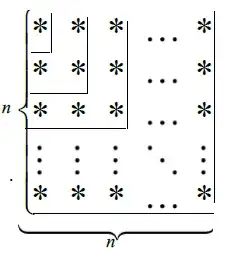To some extent: yes, it is a matter of trial and error, but you can get quite educated about it. But I'll answer your question properly later on, because it is an important and good question and independent of the particular examples used to illustrate it.
With $\sum(2i-1)$, simply adding a few terms by hand shows you that the answer is $n^2$. Proving that the answer is $n^2$ is then just a matter of proving that going from $n=N$ to $n=N+1$ means adding $2N+1$ to the total, and going from $N^2$ to $(N+1)^2$ means adding $2N+1$ to the total… so if it's true for $n=N$ then it's true for $n=N+1$. That's the inductive step. As for the first term in the deduction, that depends on taste and personality. Some people like to think that the sum of the first 1 odd numbers is 1; others, that the sum of the first 0 odd numbers is 0. Each kind of person secretly despises the other.
On the other hand, it has to be said that Spivak seems not to want you to use induction here, if you are meant to use the knowledge that $1+2+3+...+n =\frac12{n(n+1)}$ (and where did that knowledge come from, pray, if not from induction?). All you do is take the total of all numbers up to $2n$ (ie. $\frac12{2n(2n+1)}$) and get rid of the even numbers by subtracting twice the total of all numbers up to $n$ (i.e. twice $\frac12{n(n+1)}$). Which, written out, is very easy and gives you $n^2$. But it is not induction.
If you happen to know $\sum{i^2}$ then the second question is much like the first (but remember to subtract four times the shorter series from the longer one, because of the squaring). This is also not anything to do with deduction.
So, then: "In problems like these does one just do a bunch of trial and error, as I have done for quite a while now, or is there a more clever way to go about it?".
Here are three approaches to finding the sums of series before starting to prove the result. It's good to have all of them available.
- Know $\sum{i^a}$ for $a=0, 1, 2, 3$. It doesn't require much memorising. Then combine the sums for whatever you are being asked to find the sum of (including using the trick that Spivak is making you use here).
- Note that $\sum{1}=n/1!$, $\sum{i}=n(n+1)/2!$, $\sum{i(i+1)}=n(n+1)(n+2)/3!$, $\sum{i(i+1)(i+2)}=n(n+1)(n+2)(n+3)/4!$, and so on for ever. The inductive proof of these is very easy and the patterns themselves are easy to memorise. Every polynomial can be expressed as the sum of multiples of these easily-summable pieces. In fact, this is the way I was first taught to work out $\sum{i^2}$.
- Be brutal. Note that a sum of values of a polynomial of degree $a$ will be a polynomial of degree $a+1$. So, for instance taking a sum of squares, say that the sum is $ax^3+bx^2+cx+d$ and prove this by induction. As you go through the inductive proof, you will be forced to give values to the coefficients to make the induction work. In this way you can find the values of all the coefficients and prove the result, both at the same time.
And the other half of your "Trial and error?" question is this: sums based on consecutive numbers (1, 2, 3,... rather than 1, 3, 5,... or even 1, 2, 4, 5, 7, 8, 10,...) are always easier. So if you have a sum which - as in Spivak's exercise - doesn't take in all consecutive values of $i$, the first thing you should do is put it together from sums which are made of consecutive values. This is a skill (or an instinct) which helps in many areas of maths, notably combinatorics.
